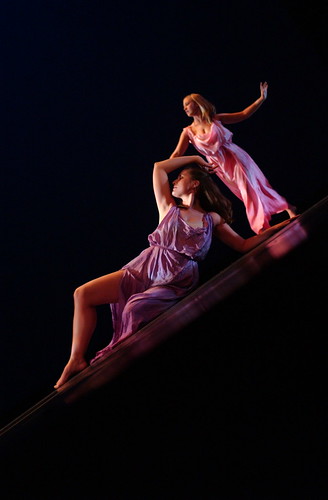
Isadora Duncan was an American dancer born in San Francisco in the late 1800’s. Adopting a free-form, expressive style of movement which she performed barefoot and in loose-fitting tunics (a departure from the rigid attire of the time), she became one of the fore-runners of modern dance.
Her early public appearances in the United States were unsuccessful and, like many of modern dance’s early pioneers, Isadora traveled abroad to Europe. There, her work garnered recognition and appreciation by audiences. Her dances, inspired by ancient Greek sculpture and philosophy, were characterized by expressive and free-flowing movement and gesture. They captured the imaginations of those familiar only with the convention and structure of ballet, an art form which was experiencing a decline in the early 20th century.
A rebel at heart, Isadora defied social norms. She was outspoken in her disdain for marriage and even jazz music which was gaining popularity at the time, preferring instead the classics of Brahms, Wagner, and Beethoven. Her two children, who later perished when the car in which they were riding rolled into the Seine river, were fathered by two different men. Her choices garnered public and political attention. She was both revered and ridiculed, considered by some to be a revolutionary and labeled a harlot by others. In Russia she met a poet seventeen years her junior and married him in 1922 so that she could bring him along on tour to the United States. Accused of being a Bolshevik agent, Duncan fled America for the final time.
She lived the rest of her short life on the French Riviera where she died tragically when her trademark long, flowing scarf became entangled in a motorcar wheel, strangling her. An innovator ahead of her time, her natural and free dance liberated the dance formula and paved the way for the development and acceptance of the modern dance art form.
“Isadora Duncan.” Encyclopedia Britannica. 2009. Encyclopedia Britannica Online. 13 Apr. 2009.
Learn More About Isadora
- Isadora was also a dance educator, founding and inspiring several schools of dance. Read more about her legacy and the history of her “Isadorables” at the Isadora Duncan Foundation for Contemporary Dance whose resident company, directed by Lori Belilove (a third-generation Duncan dancer), performs the Duncan repertoire.
- From the Virtual Museum of the City of San Francisco, a fascinating account of Isadora’s life, including glimpses from her childhood. Written by Samuel Dickson, this was originally one of the KPO/KNBC radio scripts, later printed in “San Francisco Kaleidoscope,” Stanford University Press, 1949.
- Ismene Brown looks back at Isadora’s controversial life and asks, “Isadora Duncan– sublime or ridiculous?” A really interesting article.
- Short and sweet observations by Henrietta Cullinan, made after her attendance at the Royal Ballet’s recent performance of the ballet, Isadora. I just enjoyed her comparisons to Madonna and her remarks regarding Isadora’s dislike of jazz music.
Isadora-Inspired
- Photographer, Hila’s beautiful shot of Tamara Rojo dancing Isadora Duncan Waltzes, choreographed by Frederick Ashton. Check out the accompanying video for an excerpt of this work.
- A lovely poem by Kirsten Olson entitled Isadora Duncan’s Fire. “My mother played piano. And I, Isadora, would dance.” Read on…
- Catherine Galasso premiered work in San Francisco about Joshua Norton, an eccentric businessman in the city’s history. The work features Isadora Duncan in its cast of characters and the blog provides reference material regarding this work-in-progress. There is interesting documentation of the process of recreating Duncan, and using her movement style as the basis for a contemporary re-interpretation.
Did You Know?
- That San Francisco Bay Area dancers are given the opportunity to be recognized and honored by the Isadora Duncan Dance Awards Committee? The awards and ceremony are known as the Izzies and dance blogger/San Francisco Ballet principal, Maria Kochetkova is a past recipient.
- That Isadora Duncan is the subject of a graphic biography (i.e. comic book)? You can read an interview with author, Sabrina Jones at comicbookresources.com, and a review/description of the book at Girl w/Pen.
List some ways you might study, incorporate, or re-invent Isadora Duncan in your classes or at your studio so in the comments below.
Nichelle Suzanne is a writer specializing in dance and online content. She is also a dance instructor with over 20 years experience teaching in dance studios, community programs, and colleges. She began Dance Advantage in 2008, equipped with a passion for movement education and an intuitive sense that a blog could bring dancers together. As a Houston-based dance writer, Nichelle covers dance performance for Dance Source Houston, Arts+Culture Texas, and other publications. She is a leader in social media within the dance community and has presented on blogging for dance organizations, including Dance/USA. Nichelle provides web consulting and writing services for dancers, dance schools and studios, and those beyond the dance world. Read Nichelle’s posts.


